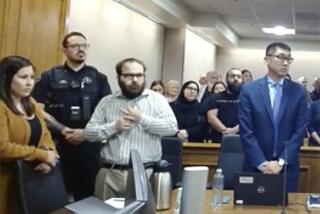Executioner’s Myth : The Abyss at the Center of Senseless Killings
- Share via
CHICAGO — Two small-town New Jersey youths allegedly murder two pizza delivery men they didn’t even know. The victims were randomly chosen. These killings made even less sense than other recent murders of victims unknown to their attackers.
In small-city South Bend, Ind., a young black man, also unknown to his killer, was similarly a random victim, but this time in a racially motivated revenge slaying connected with a romance. Some parts of this plot were more familiar. Cruel and chilling as the event was, it made some sort of sense.
Similarly, in big-city Chicago, three youths beat up and left near death an African American boy, unknown to them, who merely happened to be riding his bicycle on what they considered to be their turf. A stunned and grieving citizenry finds such an attack revolting. But the motivation was chiefly racial, thus in a category all too familiar. Again, it made some sort of sense.
In the slayings of the pizza delivery men on April 19, authorities arrested and charged Thomas J. Koskovich and Jason Vreeland, ages 18 and 17, respectively. They allegedly lured their victims to a remote spot late at night for no other purpose than to shoot them. The headlines appropriately screamed “Senseless.”
Cheered as citizens must be by any news of declining crime rates, especially murder rates, among young people, they mute their cheers when they ponder the senselessness of these attacks and killings.
In the New Jersey case, one first rounds up all the usual suspects among motivations, but none work. Dismiss race, revenge and love affairs gone wrong. Throw out domestic violence, aggravation by neighbors and traffic disputes ending in gunfire. The abused didn’t act against their abusers. Drugs may have played some part, but they did not seem to be central. Ghetto deprivation or gang warfare was not a factor. The easy availability of guns is not the main point of this story: The killers stole the weapons. The slayings were not the result of bungled burglaries, attempts at theft. The killers did not care who their victims were. If all the other recent killings were assaults on the ordinary senses of ordinary people, this one claimed a separate category in the annals of senselessness, plotlessness.
Those who know Koskovich say he liked to call himself crazy and showed himself crazy to kill. The killers killed just to kill, just to see what it felt like, some said, as if they were capable of showing feelings.
Efforts to make sense of this might well lead one to the dictionary of pathologies, or to just any old dictionary, preferably one that includes foreign words imported for diagnoses. Some experts might suggest as a cause “anomie”--alienation and purposelessness experienced by a person or a class as a result of a lack of standards and values; personal disorganization resulting in unsocial behavior. If that Greek word will not suffice, others might try a more familiar Latin root, as in “nihilism”--a doctrine holding that all values are baseless and that nothing can be known or communicated. But even these two choices at least imply that there have been standards and values and doctrines. The teen killers did not seem to start with any such bases.
A third dictionary choice focuses on what we see when we look for where the soul was supposed to be, in the center of these killers’ and attackers’ beings. Instead, we see an “abyss”--an unfathomable chasm; a yawning gulf or void. A dictionary adds that an abyss is “the abode of evil spirits; hell.” In the abyss, that void instead of a center of these persons, one discerns only an atrophy of the imagination. They are all incapable of picturing themselves as the victims. Here is also a paralysis of that imagination; they are unable to conceive what life will be like for the survivors of the killed--or even for the killers’ own families, who will have to reckon with the pointlessness of it all.
Americans never like to leave stories of human nature and action lost in the abyss. Foreign observers like to say that we try to put a spin or a gloss on the worst of stories. There must be a positive lesson, a hint of good outcomes beyond such abysses. So, in compensation, we do rejoice to read of declines in youth crime rates. Therapeutically to put names on the idiocies and shadows in human nature, we read novelists like Dostoevsky and Conrad and Faulkner. At our best, we engage in efforts to change the circumstances in which evil takes rise: replace slums; find jobs; break up gangs; fight drugs; carry on legislative assaults against assault weapons; try to replace media imagery that glorifies killing with something more positive; set forth adult exemplars of standards and values. Most of all, do whatever one can to reach imaginations and try to recreate an ability to be empathetic.
To speak of an abyss in the soul, or where the soul was to have functioned, is to move toward a theological zone. Most religions deal with human nature not in its middling range but in its depths and heights. Their adherents gape at unfathomable degradations, but never lose sight of the possibilities of generosity, nobility and sympathy that we see in humans at their best. Those who think theologically are given no choice by their faiths: These killers have to be thought of as children of God, created in a divine image.
It takes astounding imagination to think of the alleged killers Koskovich and Vreeland, the South Bend revenge-seekers and the three Chicago racist youths as children of God. For those not theologically minded, it is equally challenging to think of them as children intended for nobler existence. One has no right to expect such affirmative thinking from those who mourn Georgio Gallara and Jeremy Giordano, the slain pizza-delivery men, who were really good people, say all their neighbors. They were honest and dutiful men who were only doing their business, taking risks, hoping to improve their lives and give pleasure to others. Or how can the family of Leonard Clark, the beaten Chicago 13-year-old, think of three thuggish racists as divinely imaged? And in South Bend, would the survivors of randomly slain Robert Wardlow Jr. be called to view his killers in any range except that of the abyss?
Excuse them from having to engage in such acts of imagination; others at some distance might begin the “reconceivings.” If only the killers could have thought of their victims and themselves in some named, personal and, therefore, positive and empathizing way, we would not be reading of the abysses of horrors. Instead, more energy could go into momentarily enjoying news of some small statistics indicating that life, not death, could again set the standards and values for a society, more of which might find or make sense.
More to Read
Sign up for Essential California
The most important California stories and recommendations in your inbox every morning.
You may occasionally receive promotional content from the Los Angeles Times.










